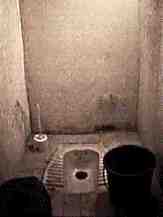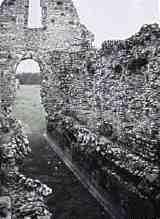Chamber Pots
HISTORICAL BACKGROUND
In the earliest times, human beings were so thinly populated that there was no need for special sanitary facilities. As migratory hunters and gatherers settled down to live on fixed farmsteads, the need emerged. Some of the earliest evidence for domestic toilet arrangements was found in a group of Neolithic huts on Skara Brae in the Orkney Islands. These stone structures had recesses in the walls with drains leading to what appears to be a crude sewer system (Colman, 5).
From the beginning of civilization, there were two basic types of toilet, depending on whether they required a squatting or sitting posture. [Picture of Stand-up Toilet]For example, although the Babylonians used "Eastern-style" toilets, an opening in the floor, the Assyrian palace of Sargon II had a "Western-style" sit-down toilet (Colman, 8). "Toilets" in most non-Western cultures today consist of a simple hole in the floor. This forces one to assume a full squat posture, which gives the stomach muscles proper support during the defecation process. The development of less biologically efficient sit-down toilets may be related to changes in clothing styles. Where loose robes are the standard form of attire, these can be gathered up around the waist to leave the legs free. Where some form of trousers, leggings, or hose have become standard, they interfere with the ability to squat without soiling oneself or one's clothing (Kira, 118-19). Efforts to adopt the western style in eastern lands have often been frustrated by the tendency for users to climb up on the seat and stand there while doing their business (Pudney, 52).
Around 2500-1500 BCE, the Indus Valley civilization appears to have had latrines that hand-flushed into the street drains (Wright, 10). The drain system emptied into a main cesspool that was apparently cleaned out regularly by public workers Colman, 14). The mechanical flush toilet was invented for the first time about 200BCE. The ground floor of the Palace of Knossos in Crete had a latrine with a wooden seat, an earthenware pan, and a reservoir for flushing water (Wright, 7). The water closet was not invented again until Sir John Harington developed a valve toilet in 1598, one of which was installed in the palace of his godmother, Queen Elizabeth I, at Richmond (Wright, 75). The idea was then almost forgotten again for over a century, and water closets remained very rare in England until almost 1800 (Wright, 103-07). Incidentally, although Thomas Crapper actually existed, he was not the inventor of the modern toilet.
[Latrina at Ephesus]An idea related to the flush toilet was to situate privies over a natural or artificial water channel to carry the waste away. This was a common design in Roman times (Wright, 21). The well-known Latrina [left] at Ephesus is built in this way (Erderngil, 72). It was also the usual arrangement for the rere-dorter, or sanitary wing, of medieval monasteries [as seen in the example from Castle Acre Priory to the right below]. [Rere-dorter at Castle Acre Priory] The availability of water for sanitation was a major factor in the location of religious houses (Wright, 50). The convenience of sewage disposal was one reason for the popularity of the 138 houses located on London Bridge--although this popularity posed risks to boatmen passing beneath (Wright, 50). Since Port Royal had no streams, this option was not available there.



